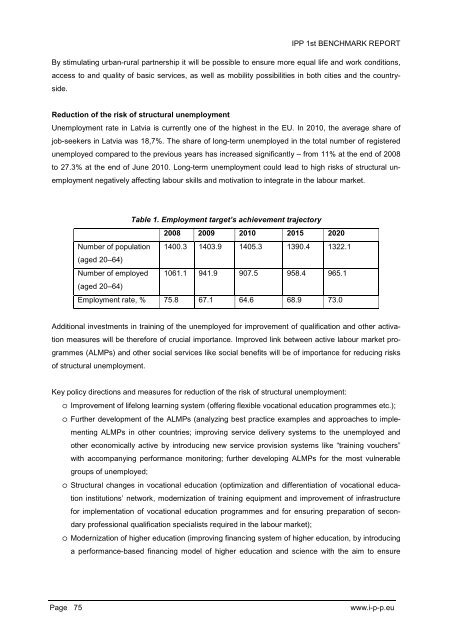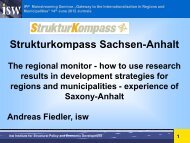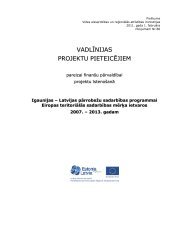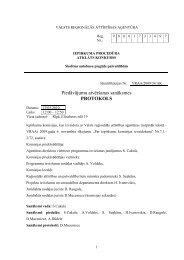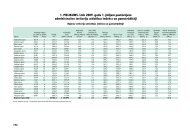Benchmark Study 1
Benchmark Study 1
Benchmark Study 1
You also want an ePaper? Increase the reach of your titles
YUMPU automatically turns print PDFs into web optimized ePapers that Google loves.
IPP 1st BENCHMARK REPORT<br />
By stimulating urban-rural partnership it will be possible to ensure more equal life and work conditions,<br />
access to and quality of basic services, as well as mobility possibilities in both cities and the countryside.<br />
Reduction of the risk of structural unemployment<br />
Unemployment rate in Latvia is currently one of the highest in the EU. In 2010, the average share of<br />
job-seekers in Latvia was 18,7%. The share of long-term unemployed in the total number of registered<br />
unemployed compared to the previous years has increased significantly – from 11% at the end of 2008<br />
to 27.3% at the end of June 2010. Long-term unemployment could lead to high risks of structural unemployment<br />
negatively affecting labour skills and motivation to integrate in the labour market.<br />
Table 1. Employment target’s achievement trajectory<br />
2008 2009 2010 2015 2020<br />
Number of population 1400.3 1403.9 1405.3 1390.4 1322.1<br />
(aged 20–64)<br />
Number of employed 1061.1 941.9 907.5 958.4 965.1<br />
(aged 20–64)<br />
Employment rate, % 75.8 67.1 64.6 68.9 73.0<br />
Additional investments in training of the unemployed for improvement of qualification and other activation<br />
measures will be therefore of crucial importance. Improved link between active labour market programmes<br />
(ALMPs) and other social services like social benefits will be of importance for reducing risks<br />
of structural unemployment.<br />
Key policy directions and measures for reduction of the risk of structural unemployment:<br />
o Improvement of lifelong learning system (offering flexible vocational education programmes etc.);<br />
o Further development of the ALMPs (analyzing best practice examples and approaches to implementing<br />
ALMPs in other countries; improving service delivery systems to the unemployed and<br />
other economically active by introducing new service provision systems like “training vouchers”<br />
with accompanying performance monitoring; further developing ALMPs for the most vulnerable<br />
groups of unemployed;<br />
o Structural changes in vocational education (optimization and differentiation of vocational education<br />
institutions’ network, modernization of training equipment and improvement of infrastructure<br />
for implementation of vocational education programmes and for ensuring preparation of secondary<br />
professional qualification specialists required in the labour market);<br />
o Modernization of higher education (improving financing system of higher education, by introducing<br />
a performance-based financing model of higher education and science with the aim to ensure<br />
Page 75<br />
www.i-p-p.eu


